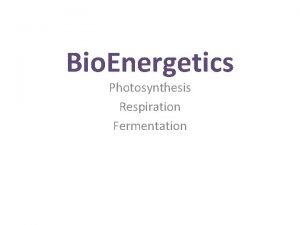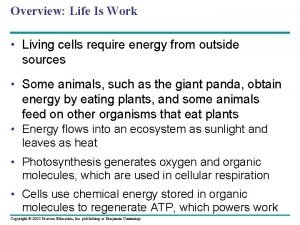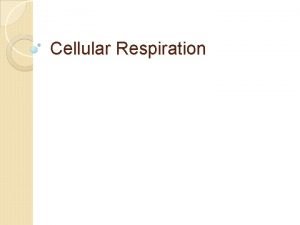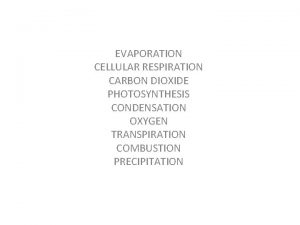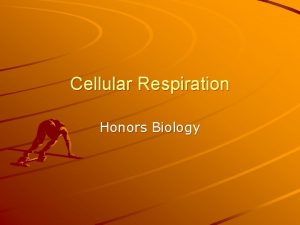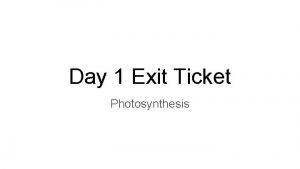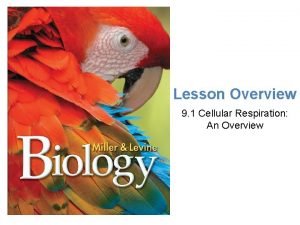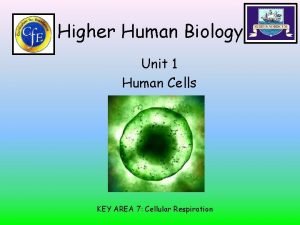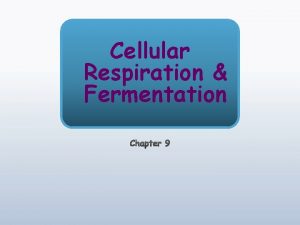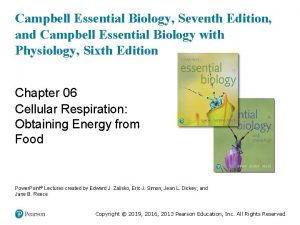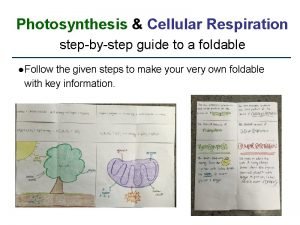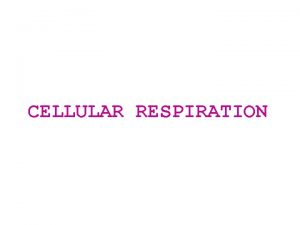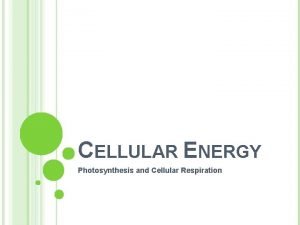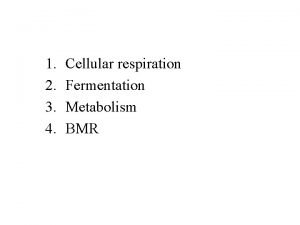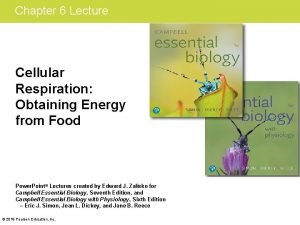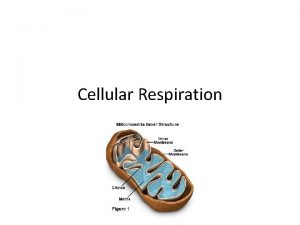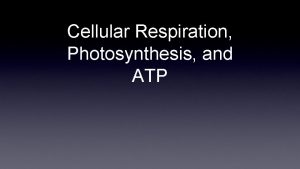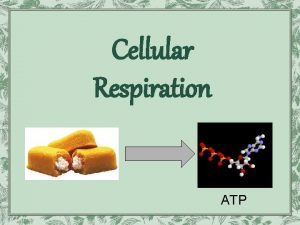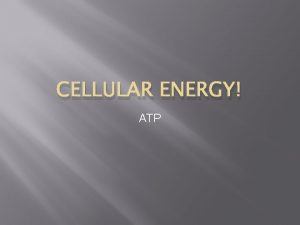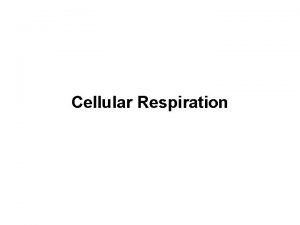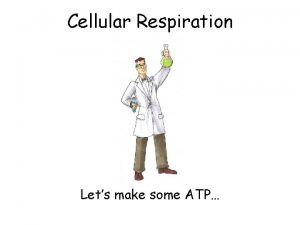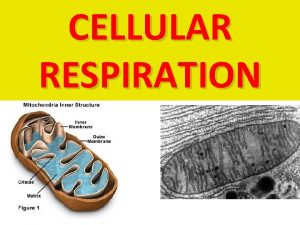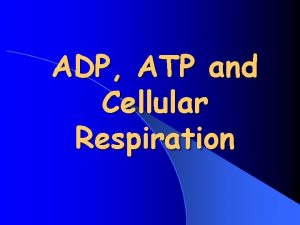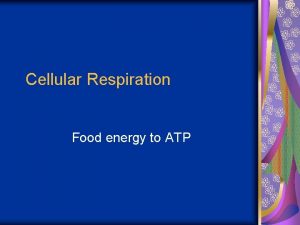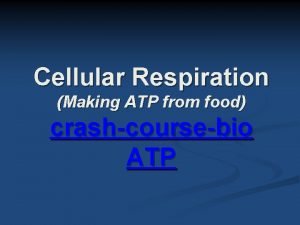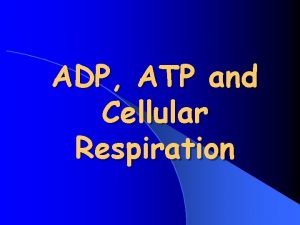Overview of Cellular Respiration Cellular respiration makes ATP





















- Slides: 21


Overview of Cellular Respiration Cellular respiration makes ATP by breaking down sugars and other carbon-based molecules • Cellular respiration is aerobic (requires oxygen) • Takes place in mitochondria (cell “powerhouse”)

Generally: 1. GLYCOLYSIS = Glucose is broken down into Pyruvate, NADH, and a small amount of ATP (Cytoplasm) 2. OXIDATIVE RESPIRATION = With O 2 Pyruvate + NADH make a large amount (Mitochondria) of ATP – or – 2. FERMENTATION = Pyruvate converted to lactic acid or ethyl alcohol (ethanol) + CO 2 Without O 2 (Cytoplasm)

Process starts with Glycolysis (means “glucose breaking”) • 6 -carbon glucose broken into two 3 molecules of pyruvic acid carbon • Produces 2 molecules of ATP (makes 4, but uses 2 ATP = net of 2 ATP)

• anaerobic process (does not require oxygen) • Takes place in cytoplasm • Products of glycolysis used in respiration process.

Cellular Respiration takes place in two main stages 1. Krebs cycle takes place in interior space of mitochondria.

• 3 -carbon molecules produced in glycolysis are broken down in a cycle of chemical reactions • Carbon dioxide is given off (CO 2) • Energy produced is transferred to 2 nd stage (energy in the form of 2 ATP and other “charged” molecules: NADH and FADH 2)

2. Electron Transport Chain takes place in inner membrane • Electrons are passed along • Their energy is used to pump [H+] against concentration gradient

• Produces 34 ATP (for a total of 36 including Glycolysis) • Oxygen enters process and picks up final electrons and hydrogen to make H 2 O (water) • Many enzymes required for process 2 2 32

Overall equation of cellular respiration C 6 H 12 O 6 + 6 O 2 6 CO 2 + 6 H 2 O + E

Cellular respiration is like mirror image of photosynthesis • Chemical equation for cellular respiration is basically the reverse of that for photosynthesis • Structures in chloroplast and mitochondria are similar 6 CO 2 + 6 H 2 O + E C 6 H 12 O 6 + 6 O 2 6 CO 2 + 6 H 2 O + E

Comparing Photosynthesis and Cellular Respiration (reactants of photosynthesis are same as products of cellular respiration)

Fermentation • Takes place in cytoplasm • Fermentation allows glycolysis to continue making ATP when oxygen is unavailable (no E. T. C. )

Fermentation is an anaerobic process • Occurs when oxygen not available for cellular respiration • Does not produce ATP • NAD+ is recycled to glycolysis

1. Lactic Acid Fermentation • occurs in muscle cells • Glycolysis splits glucose into two pyruvate molecules • Pyruvate and NADH enter fermentation

• Energy from NADH converts pyruvate into lactic acid • NADH is changed back into NAD+

2. Alcoholic fermentation similar to lactic acid fermentation • Products of alcoholic fermentation include cheese, bread, yogurt • Glycolysis splits glucose and products enter fermentation

• Energy from NADH is used to split pyruvate into an alcohol and carbon dioxide • NADH is changed back into NAD+ • NAD+ is recycled to glycolysis • Yeast and bacteria

Energy and Exercise Quick Energy • Cells contain only enough ATP for a few seconds of intense activity • Then cells rely on lactic acid fermentation (can supply for about 90 seconds) • Lactic acid build-up causes burning in muscles. Only way to get rid of lactic acid is chemical pathway that requires oxygen (why you breathe heavy after heavy exercise. )

Long Term Energy • Cellular respiration only way to produce continuous supply of ATP • Energy stored in muscles and other tissue in form of carbohydrate glycogen • Enough glycogen for about 15 to 20 min. • When glycogen used up, body breaks down other stored molecules including fats, for energy.

A variety of organic molecules can be utilized to produce energy. These molecules enter the Krebs cycle different stages.
 Autotrophs and heterotrophs
Autotrophs and heterotrophs Total atp produced in cellular respiration
Total atp produced in cellular respiration Cellular respiration
Cellular respiration Equation for cellular respiration
Equation for cellular respiration Aerobic respiration overview
Aerobic respiration overview Overview of cellular respiration
Overview of cellular respiration Overview of cellular respiration
Overview of cellular respiration Cellular respiration formula
Cellular respiration formula The gray-brown haze often found over large cities is called
The gray-brown haze often found over large cities is called Is cellular respiration
Is cellular respiration Cellular respiration redox
Cellular respiration redox Wood badge ticket examples
Wood badge ticket examples Cellular respiration
Cellular respiration Higher human biology cellular respiration
Higher human biology cellular respiration Cellular respiration
Cellular respiration Consumer
Consumer Functions of cellular respiration
Functions of cellular respiration Photosynthesis and cellular respiration foldable
Photosynthesis and cellular respiration foldable Cellular respiration is a complex process that
Cellular respiration is a complex process that Function of cellular respiration
Function of cellular respiration Macromolecules in cellular respiration
Macromolecules in cellular respiration Cellular respiration obtaining energy from food
Cellular respiration obtaining energy from food
